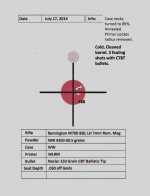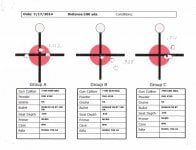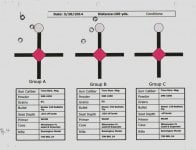Darkhorse
Handloader
- Mar 14, 2014
- 819
- 172
 This was my first range session since my total knee replacement and I didn't shoot so well. This was also my first session with the CTBT bullet.
This was my first range session since my total knee replacement and I didn't shoot so well. This was also my first session with the CTBT bullet.My barrel was squeaky clean and the first 3 fouling shots from a cold barrel were the best group. This was a surprise even though the load is the most accurate I've found with the regular BT's, these were only intended as fouling shots. All groups impacted very near the same POI.
I'm looking for an accurate load at 63. grains of IMR 4350 for hunting. And so far the CBT's are shooting better than the regular Ballistic Tips at this load. The bullet seems to want more jump so the next set will all see a deeper seat depth.
On group A, I pulled the last shot, it is the one to the left, out of the group. On group B, I also pulled the last shot it is low to the right. Group C felt good and I will shoot it again.
I will also increase the size of the red circles to match the one on the single target as I could see it much better in the scope.
All the groups hit right and low of the regular Ballistic Tips and were generally more accurate, even with the shooter errors.
Since these are the first shots with a clean barrel I don't know what to expect from this coated bullet, perhaps the groups will tighten with more shots down the barrel.






